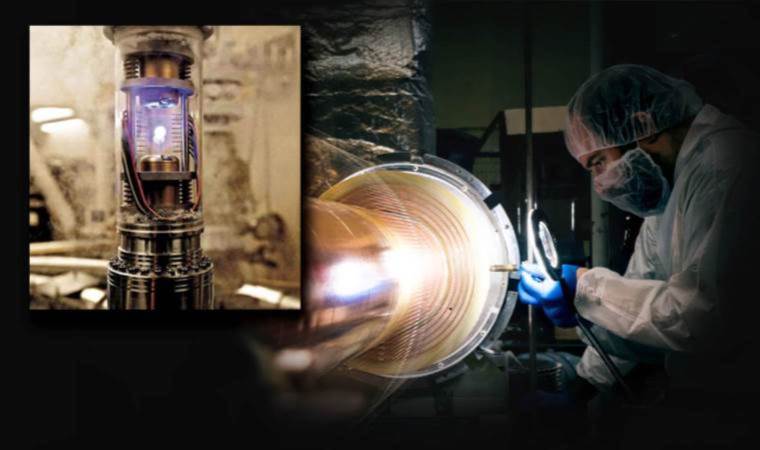The world's most expensive substance: A gram costs 62 trillion dollars!
The most expensive substance in the world is valued at a staggering 62 trillion dollars per gram. This incredible material, which takes 100 billion years to produce, is used in medical imaging equipment.

When thinking of the world's most expensive substance, one might consider gold, a rare type of diamond, or expensive culinary ingredients like saffron. However, it's none of these.
The 2009 movie "Angels and Demons," starring Tom Hanks, briefly referenced this rare substance. If you have seen the film, this information might be familiar to you.
The name of this substance is "antimatter," and just one gram of it is priced at 62 trillion dollars. The creation of that one gram takes an entire 100 billion years...
What is Antimatter?
Antimatter, also known as counter matter or opposite matter, is simply the opposite of matter. It consists of fundamental particles that are opposite in charge to matter.
When antimatter interacts with normal matter, it releases energy, and this interaction results in the annihilation of both matter and antimatter. For example, an electron's antimatter counterpart is called a positron, and when an electron and a positron come together, they annihilate each other, releasing energy.
Antimatter was formed alongside normal matter after the Big Bang. Although the reason for its rarity in the universe is not fully understood, it is extremely scarce. According to Hanks's film, when antimatter comes into contact with matter, it can cause a massive explosion, as opposing forces are not compatible.
Why is Antimatter So Expensive?
Antimatter, produced using CERN's Large Hadron Collider (LHC), is extremely rare costly, and difficult to obtain. In 1999, NASA scientists estimated the cost of producing just one gram of antimatter to be 62 trillion dollars.
Considering the International Monetary Fund (IMF) estimated the total value of the world's economy to be 104 trillion dollars last year, this figure becomes even more remarkable.
The operating cost of CERN LHC is about 1 billion dollars annually, and in addition, the electricity costs reach 23.5 million dollars per year. The accelerator needs to accelerate to nearly the speed of light to create this substance, which significantly increases operating costs.
Considering it takes about 100 billion years to create antimatter, the price tag of 62 trillion dollars becomes somewhat more understandable.
Where is Antimatter Used?
Despite being unstable, antimatter is incredibly useful. Experts believe that if used carefully, it has the potential to support intergalactic space travel. Currently, it is used in medical imaging equipment, especially in positron emission tomography (PET) scanners.
Potential Uses of Antimatter:
In Medicine, Positron Emission Tomography (PET): Antimatter is already being used in medicine. PET scans use positrons (a form of antimatter) to diagnose conditions like cancer and brain diseases.
In Space Exploration and Propulsion Systems: Theoretically, the incredible energy density of antimatter makes it an ideal candidate for spacecraft propulsion systems. Antimatter-matter reactions could produce large amounts of energy to accelerate spacecraft.
In High Energy Physics Research: Particle accelerators like the Large Hadron Collider are used to produce antimatter particles and understand the fundamental laws of physics.
In Energy Storage and Production: Theoretically, the high energy density of antimatter could be a potential solution for future energy storage and production.
In Material Science and Testing: Antimatter could be used to examine the internal structures of materials.
In Astrophysics and Cosmology: Antimatter plays a significant role in astrophysics studies to understand the structure of the universe and mysterious phenomena like dark matter.
How Was Antimatter Discovered?
Antimatter was theoretically predicted in the early 20th century and later experimentally discovered. Here are the main points of this discovery:
Theoretical Foundations (1928): The concept of antimatter was first proposed by British theoretical physicist Paul Dirac in 1928. Dirac developed an equation combining quantum mechanics and the theory of special relativity. This Dirac Equation suggested the existence of an antiparticle to the electron. This antiparticle would have the same mass and lifespan as an electron but an opposite electric charge.
Experimental Discovery (1932): The first experimental evidence of antimatter was provided by Carl Anderson in 1932. Using a cloud chamber in cosmic ray research, Anderson discovered the antiparticle of the electron, later named the positron. The positron had the same mass and lifespan as predicted by Dirac, but an opposite electric charge.
Verification of the Discovery: Anderson's findings were quickly verified by other scientists, leading to the widespread acceptance of the concept of antimatter. The discovery of the positron was a turning point in particle physics and highlighted the importance of combining quantum mechanics and special relativity.
Discovery of More Antiparticles: Following the discovery of the positron, other antiparticles were also discovered. For example, the antiproton, the antiparticle of the proton, was discovered in 1955, and the antineutron, the antiparticle of the neutron, was discovered in 1956.
The discovery of antimatter was a fundamental turning point in modern physics and profoundly affected our understanding of the building blocks of the universe. This discovery opened new paths of research in both theoretical physics and experimental particle physics.
Most Read News
-
 Sanctioned tankers leave Venezuela as US tightens oil bl
Sanctioned tankers leave Venezuela as US tightens oil bl
-
 Spain says Venezuela’s natural resources belong to its p
Spain says Venezuela’s natural resources belong to its p
-
 US forces attempt to board Russian-flagged oil tanker in
US forces attempt to board Russian-flagged oil tanker in
-
 Israel issues tender to build over 3,400 settler homes i
Israel issues tender to build over 3,400 settler homes i
-
 NATO chief welcomes progress on securing 'end to Ukraine
NATO chief welcomes progress on securing 'end to Ukraine
-
 US demand for exclusive oil partnership with Venezuela a
US demand for exclusive oil partnership with Venezuela a
-
 US officials say raid to capture Venezuela’s Maduro left
US officials say raid to capture Venezuela’s Maduro left
-
 Venezuela opposition leader Machado pushes leadership cl
Venezuela opposition leader Machado pushes leadership cl








